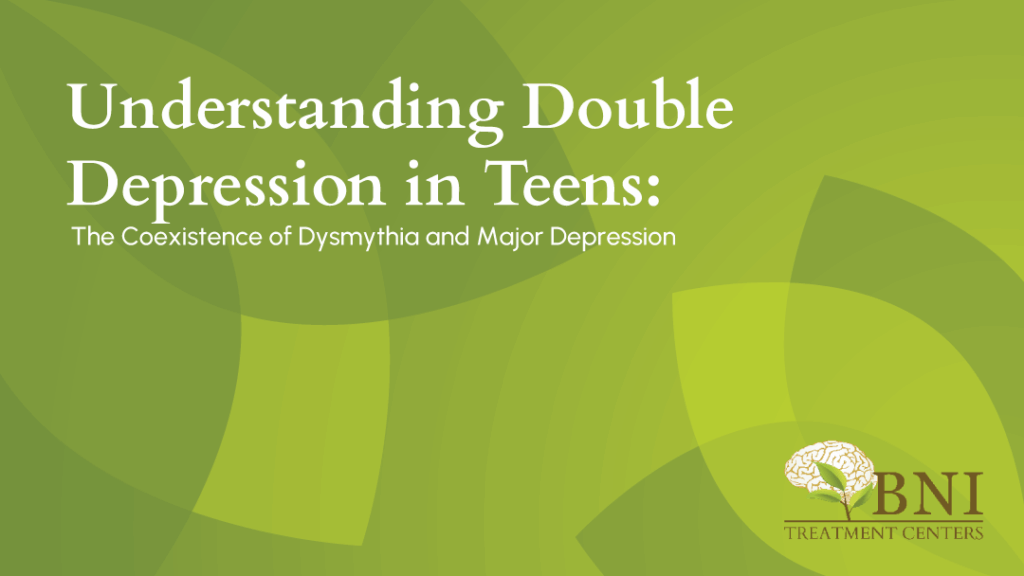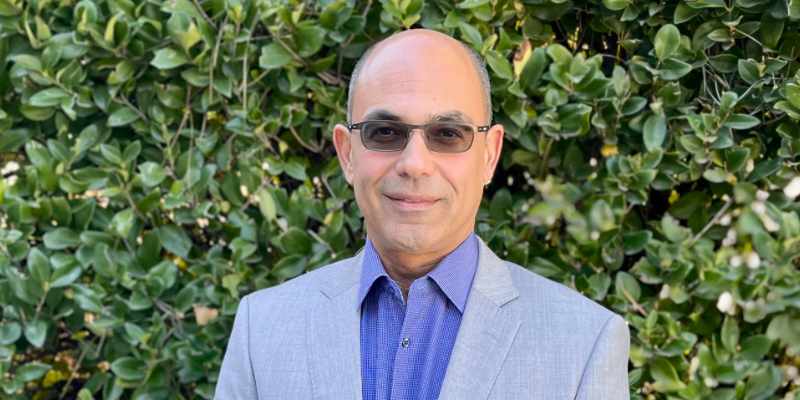
Observing a decline in your teen’s mood and overall well-being can be deeply concerning. As symptoms persist over time, shifting from days to weeks or even months, it may become increasingly evident that your teen is struggling with more than temporary sadness.
This is very real for many teens throughout California. In 2021, over 20% of teens ages 12-17 reported experiencing at least one major depressive episode.
Though depression is an umbrella term, its subtypes can affect teens in different ways. Double depression occurs when both major depressive disorder and persistent depressive disorder exist at the same time.
At BNI Treatment Centers, we understand the debilitating effects depression has on teens. In this article, we will discuss double depression in teens, the symptoms it causes, and how to treat the condition successfully.
Understanding Double Depression: When Two Forms of Depression Coexist
Double depression is not a clinical term; however, it is characterized by the coexistence of persistent depressive disorder (PDD) and major depressive disorder (MDD). When both mood disorders are present, teens experience a chronic, low-grade depressive state accentuated by more severe episodes of major depression.
These two depressive disorders combined significantly impact daily functioning and reduce quality of life, especially in adolescents. Research has indicated that those diagnosed with dysthymic disorder (a sister term for PDD) before the age of 21 are likely to develop double depression. Key factors of the 10-year study included older age, less education, co-occurring anxiety disorders, chronic depression in other family members, poor maternal relationships, and experiencing sexual abuse as a child.
Persistent Depressive Disorder (PDD): The Chronic Underlying Mood Condition
Formerly known as dysthymia or dysthymic disorder, persistent depressive disorder is defined by a persistently low mood lasting at least one year in adolescents. Common symptoms include:
- Appetite changes involving eating too little or overeating
- Insomnia or hypersomnia
- Persistent low energy or fatigue
- Low self-esteem
- Difficulty concentrating or making decisions
- Feelings of hopelessness
The trademark of these symptoms is that they are chronic and vary from mild to severe throughout the teen’s life. This is problematic in the diagnostic process as they are often mistaken for personality traits or normal teenage mood fluctuations.
Major Depressive Disorder (MDD): Acute Episodes Within a Depressive Baseline
Major depressive disorder involves the presence of symptoms over two weeks, with a noticeable change in daily functioning. These symptoms include:
- Low mood
- Loss of interest or pleasure in activities
- Significant weight change, either gaining or losing
- Sleep disturbances
- Increased agitation
- Fatigue
- Feelings of worthlessness or guilt
- Thoughts of death or suicide
When double depression occurs, MDD appears with the already present PDD symptoms. A significant deterioration in mood, behavior, and functioning characterizes these major depressive episodes. Adolescents exhibit withdrawn and irritable demeanors, which interfere with school attendance and performance as well as peer relationships.
Because MDD episodes occur against a backdrop of chronic dysthymia, full remission of depression is more elusive. This duality complicates the diagnostic and treatment methods.

What Triggers Double Depression in Adolescents? Clinical Insights into Causation
Double depression in adolescents results from a mix of genetic factors, ongoing stress, and developmental influences. The onset of PDD often happens during late childhood or early adolescence, but diagnosing the condition can go unnoticed for months or even years. Stressors such as academic pressure, family conflict, bullying, and social isolation worsen underlying mood symptoms and signal a major depressive episode in progress.
Research into neurobiology as a cause of major depression is constantly being conducted. While there is no singular gene or set of genes that causes depression, the variations that occur within genes (polymorphisms) can indicate that depression may occur. The serotonin transporter gene is the most studied in MDD as it can produce three different gene combinations involving long and short alleles. Those who have one or two short alleles are more likely to have an exaggerated stress response and, therefore, an increased susceptibility to depression.
Adolescent development itself introduces a range of stressors. From identity formation to hormonal shifts and increased mood swings, the teenage years are difficult to navigate. Those who are already sensitive to stress will have a higher risk of becoming overwhelmed with these changes. They may already be experiencing PDD symptoms, and being faced with new obstacles can trigger double depression to occur.
Identifying Risk Factors for Double Depression: Who Is Most Vulnerable?
Not every adolescent with PDD will go on to develop double depression. However, certain risk factors increase vulnerability:
- Having a family history of mood disorders
- Experiencing childhood trauma, such as abuse, neglect, or a chaotic home environment
- Having a chronic medical condition
- Experiencing bullying
- Partaking in substance use, especially at a young age
- Having a co-occurring mental health condition, such as anxiety
Diagnosing Double Depression: Clinical Criteria and Challenges
Double depression is not a formal diagnosis, as the DSM-5 does not list it as a clinical condition. However, many clinicians describe double depression as a subtype involving the co-occurrence of PDD with intermittent major depressive episodes.
To diagnose double depression, the adolescent must meet the full criteria for both PDD and at least one episode of MDD. This can be clinically challenging, as adolescents may underreport symptoms or fail to recognize shifts in mood severity. Symptoms of chronic depression also overlap with normal adolescent behaviors, such as moodiness or withdrawal. Consistent and repeated psychological testing is necessary to ensure a proper diagnosis is reached.
Is Double Depression More Complex to Treat Than Other Mood Disorders?
Treating double depression is complex due to the long-term symptoms of PDD and the intensity of MDD episodes. Responding to treatment may be a slower process, and adolescents may experience higher relapse rates. They also tend to have greater resistance to standard therapies compared to those with MDD alone.
Due to low mood and lack of motivation, it becomes more difficult to keep adolescents focused and committed to treatment. Those with double depression are more likely to miss appointments or stop adhering to medication regimes. Inconsistent or a lack of treatment for double depression also increases the risk of suicidal ideation, putting teens at risk for harming themselves. With guided support and help adhering to their plan, treatment can vastly improve overall mood.
Best Practices for Treating Double Depression: An Integrated Therapeutic Approach
Research for treating double depression is sparse, though methods include medications, therapies, and coping skill development. These practices are utilized in treating both MDD and PDD separately, making them the most viable option.
The most common medications used are antidepressants, specifically selective serotonin reuptake inhibitors (SSRIs). In some cases, a combination of medications will be needed for symptom relief. Side effects and symptom monitoring will need to consistently take place, as many antidepressants take weeks before they become effective.
Psychotherapies are a crucial method of treating both PDD and MDD in teens. One of the most common practices is cognitive behavioral therapy (CBT). The goals of CBT are to address negative thought patterns and behaviors and work to change them into positive ones. Through CBT, teens also learn coping skills to utilize in times of stress or despair.
Parental involvement in the treatment process is integral to the teen’s success. Psychoeducation about double depression, communication skills training, and ongoing support for both the teen and their parents will help reduce the risk of a relapse in depression symptoms.
Both PDD and MDD are chronic conditions, and continued maintenance treatment is often necessary. Though remission is possible, there is always a risk of a reemergence of double depression. Adhering to medications and therapy schedules is key to long-term success.

Treatment For Teen Double Depression at BNI Treatment Centers
Double depression can be difficult to recognize at first, especially when your teen seems to be functioning “just enough” to get by. But over time, the weight of chronic low mood combined with acute depressive episodes can become overwhelming and debilitating. The good news is that effective treatment for double depression is available, and with the right care, your teen can find lasting relief and reclaim a sense of stability and self-worth.
If your teen is showing signs of depression, we are here to help. At BNI Treatment Centers, our psychiatrist-led team offers evidence-based, personalized care that addresses both the chronic and acute components of double depression. We involve families every step of the way, helping you support your teen’s healing journey with confidence and clarity. Don’t wait to seek help – contact us today at (888) 522-1504 to learn more about our adolescent mental health programs.
BNI Treatment Centers: Science-based, evidence-backed, compassion-led




